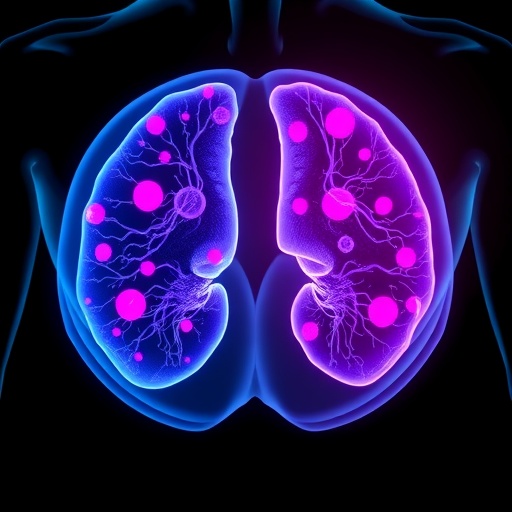Breast cancer remains the most prevalent form of cancer diagnosed among women worldwide, accounting for over 2.3 million new cases annually. Despite advancements in diagnostic techniques and treatments, predicting the likelihood of cancer recurrence continues to pose significant challenges for oncologists. Accurate risk assessment of tumor recurrence is vital for tailoring personalized follow-up care and therapeutic strategies. Addressing this critical hurdle, a pioneering international research effort spearheaded by the Universitat Rovira i Virgili has yielded an innovative artificial intelligence (AI) model. This model integrates detailed medical imaging with patients’ clinical profiles, propelling the predictive accuracy of breast cancer relapse to unprecedented levels.
At the core of this breakthrough is the fusion of dynamic contrast-enhanced magnetic resonance imaging (DCE-MRI) data with comprehensive clinical characteristics from individual patients. Traditionally, predictive systems have focused narrowly on intrinsic tumor features. However, this novel approach encompasses a holistic analysis, incorporating not only tumor morphology but also the properties of the surrounding breast tissue. Such a panoramic examination facilitates identification of subtle, yet crucial, radiomic patterns including bilateral breast symmetry and nuanced textural variations within the tumor microenvironment. These radiological biomarkers are now recognized as significant indicators correlated with the propensity for cancer recurrence.
The methodology behind this advanced model involves fully automated processing of imaging data. Initially, it segmentizes the MRI scans to isolate relevant anatomical structures. Subsequently, sophisticated algorithms extract key features related to shape descriptors, signal intensity distributions, and tissue heterogeneity. These quantitative imaging biomarkers are then amalgamated with clinical parameters such as tumor classification, hormone receptor status, and tumor grade. To handle this complex multimodal input, the research team employed TabNet, a cutting-edge neural network architecture renowned for its interpretability and superior capability in managing tabular data with intricate relational structures.
Rigorous validation of the AI system was conducted on a dataset comprising more than 500 breast cancer patients, exhibiting impressive overall accuracy metrics. In addition to high accuracy, the model demonstrated exceptional sensitivity in flagging patients at genuine risk of relapse. This heightened sensitivity is critical from a clinical perspective—it reduces false-negative predictions and ensures that individuals needing intensified surveillance or adjunctive therapies are correctly identified. According to Domènec Puig, lead investigator of the project, this feature underscores the model’s transformational potential in reframing post-treatment care paradigms.
Further analysis revealed that particular radiomic features exert significant influence on prediction outcomes. Among these, the irregular tumor texture, disrupted symmetry between the breasts, and hormone receptor expression emerged as pivotal prognostic variables. These findings not only affirm the biological relevance of the imaging-derived insights but also suggest valuable new visual and clinical metrics for oncologists. Such indicators could be seamlessly integrated into routine diagnostic workflows, enabling more precise and individualized patient management.
Beyond performance, the model holds distinct operational advantages. It is designed to be scalable and interpretable—facilitating trust and comprehension among clinicians. Furthermore, the system offers a non-invasive and cost-effective alternative to traditional genetic testing commonly used for recurrence risk evaluation. By circumventing the need for expensive molecular assays, this AI-driven tool has the potential to widen access to advanced prognostication technologies, especially in resource-limited healthcare settings.
Looking ahead, the researchers underscore the importance of large-scale validation across diverse medical institutions. This step is essential to ascertain the model’s robustness and generalizability in varied clinical environments and patient populations. The ongoing Bosomshield project, funded by the European Union’s Marie Skłodowska-Curie Doctoral Networks program, aims to facilitate such multicenter collaborations. Harnessing the synergy between medicine and state-of-the-art machine learning, the project aspires to create a new paradigm in personalized, predictive oncology.
The transformative potential of combining global and local radiomics with clinical data illustrates a broader trend in medical AI development—moving beyond isolated data silos towards integrative, systems-level prognostic models. This paradigm shift enriches our understanding of cancer biology and enhances clinical decision-making through enhanced interpretability and precision. By leveraging advanced neural networks like TabNet, researchers are pioneering models that not only predict outcomes but elucidate the “why” behind their predictions, fostering greater clinician confidence.
In conclusion, the Universitat Rovira i Virgili-led initiative offers a promising leap forward in breast cancer management. With its robust performance, sophisticated integration of imaging and clinical data, and emphasis on interpretability, this model sets a new benchmark for recurrence prediction tools. As this technology moves closer to widespread clinical implementation, it holds the promise of significantly improving patient prognoses and tailoring therapeutic interventions more effectively. The dawn of radiomics-driven precision oncology is upon us, heralding an era where data science tangibly enhances life-saving cancer care.
Subject of Research: People
Article Title: Towards Breast Cancer Recurrence Prediction Using Transformer-Based Learning from Global–Local Radiomics and Clinical Data
News Publication Date: 21-Sep-2025
Web References: http://dx.doi.org/10.1007/978-3-032-05559-0_12
Image Credits: Universitat Rovira i Virgili
Keywords: Applied mathematics




